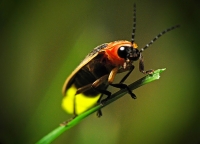Fireflies or Lightning Bugs?
A special part of summer is the sudden, floating glow of a firefly. July is a great month to visit to your local park and search for lightning bugs. Wait, are they “fireflies” or “lightning bugs”? Both common names are used to describe the same insect family and both are misleading. These glowing, six-legged creatures are beetles, not flies or bugs.
I like to call them by their scientific name: Lampyridae (I usually emphasis the “LAMP”). Not only is this name more accurate, but its Greek root means “shine” or “torch.” These beetles rest during the day and fly at night in a glowing ritual to attract a mate – creating the magical show we enjoy as both children and adults! Not only are they beautiful, but they are beneficial as well. The Lampyridae larvae are carnivorous: feeding on insects that are pests to our gardens and crops.
Perseid Meteor showers
If you find yourself chasing Lampyridae, don’t forget to look higher in the sky for stars and meteors. Mid to late-July through mid-August is the window for the Perseid Meteor showers.
The showers will peak on the night of Saturday, August 12th. In Milwaukee, the best time to view will be between 9:30 and 10:30pm – after twilight and before the moon rises.
Plan a fun evening with kids or a romantic date. All you will need is a comfortable spot to lie down away from city lights. This is both an entertaining and relaxing way to celebrate summer!
Perseid showers are named after the constellation Perseus. Emanating from the north-east, the meteors appear to be flying from Perseus (just below Cassiopeia – the big “W” in the sky) across the sky. In reality, what you are seeing is the earth’s atmosphere passing through the dustiest part of the Swift-Tuttle comet’s path. Even though we will not pass near the comet for another 109 years, we pass through its path every year. Wild! Enjoy the light show!

Stars in the sky. Photo: Neil Miles
Here Comes the Sun
Not a night owl? Check out a solar eclipse around noon on Monday, August 21st: an event that fills us with awe as we reflect on our small perspective in the giant universe!
Be sure to protect your eyes. If you don’t want to invest in a solar telescope or eclipse glasses (typically ranging from $4 to $12), you can watch indirectly as the moon passes in front of the sun by using a pin projector. Poke a hole in a card and hold it above another piece of paper letting the light shine through the card onto the paper. Or, turn your binoculars backward and let the sun reflect through the widest part of the one lens on a piece of paper- not directly into your eyes! Leave the cap on the other lens.
Take some time this summer to get out into nature and look for the lights!





